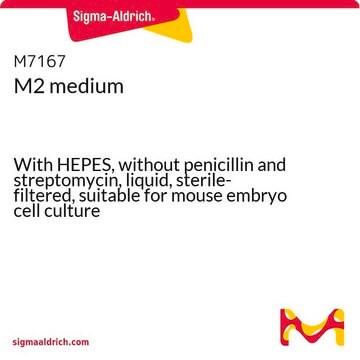MR-025
EmbryoMax® FHM Mouse Embryo Media
(1X), Liquid, w/o Phenol Red
Synonym(s):
FHM Embryo Media, Mouse Embryo Media
Sign Into View Organizational & Contract Pricing
All Photos(1)
About This Item
UNSPSC Code:
12352207
eCl@ss:
32160801
NACRES:
NA.71
Recommended Products
Quality Level
form
liquid
manufacturer/tradename
Specialty Media
EmbryoMax®
technique(s)
cell culture | embryo: suitable
cell culture | stem cell: suitable
input
sample type: mouse embryo(s)
Storage and Stability
Can be stored at -20°C up to the expiration date on the bottle. Once thawed it should be used within 2 weeks.
Note: Our EmbryoMax Liquid Mouse Embryo Media is produced on a bi-monthly basis. For regular users, we encourage standing orders to ensure that backorders do not occur
Note: Our EmbryoMax Liquid Mouse Embryo Media is produced on a bi-monthly basis. For regular users, we encourage standing orders to ensure that backorders do not occur
Legal Information
EmbryoMax is a registered trademark of Merck KGaA, Darmstadt, Germany
Disclaimer
Unless otherwise stated in our catalog or other company documentation accompanying the product(s), our products are intended for research use only and are not to be used for any other purpose, which includes but is not limited to, unauthorized commercial uses, in vitro diagnostic uses, ex vivo or in vivo therapeutic uses or any type of consumption or application to humans or animals.
Storage Class
10 - Combustible liquids
wgk_germany
WGK 2
flash_point_f
Not applicable
flash_point_c
Not applicable
Certificates of Analysis (COA)
Search for Certificates of Analysis (COA) by entering the products Lot/Batch Number. Lot and Batch Numbers can be found on a product’s label following the words ‘Lot’ or ‘Batch’.
Already Own This Product?
Find documentation for the products that you have recently purchased in the Document Library.
Customers Also Viewed
A potential use of embryonic stem cell medium for the in vitro culture of preimplantation embryos.
Gelber K. et al.
Journal of Assisted Reproduction and Genetics null
Hiroyuki Hirai et al.
Stem cells (Dayton, Ohio), 29(9), 1349-1361 (2011-07-07)
Induced pluripotent stem cells (iPSCs) can be created by reprogramming differentiated cells through introduction of defined genes, most commonly Oct4, Sox2, Klf4, and c-Myc (OSKM). However, this process is slow and extremely inefficient. Here, we demonstrate radical acceleration of iPSC
Our team of scientists has experience in all areas of research including Life Science, Material Science, Chemical Synthesis, Chromatography, Analytical and many others.
Contact Technical Service






